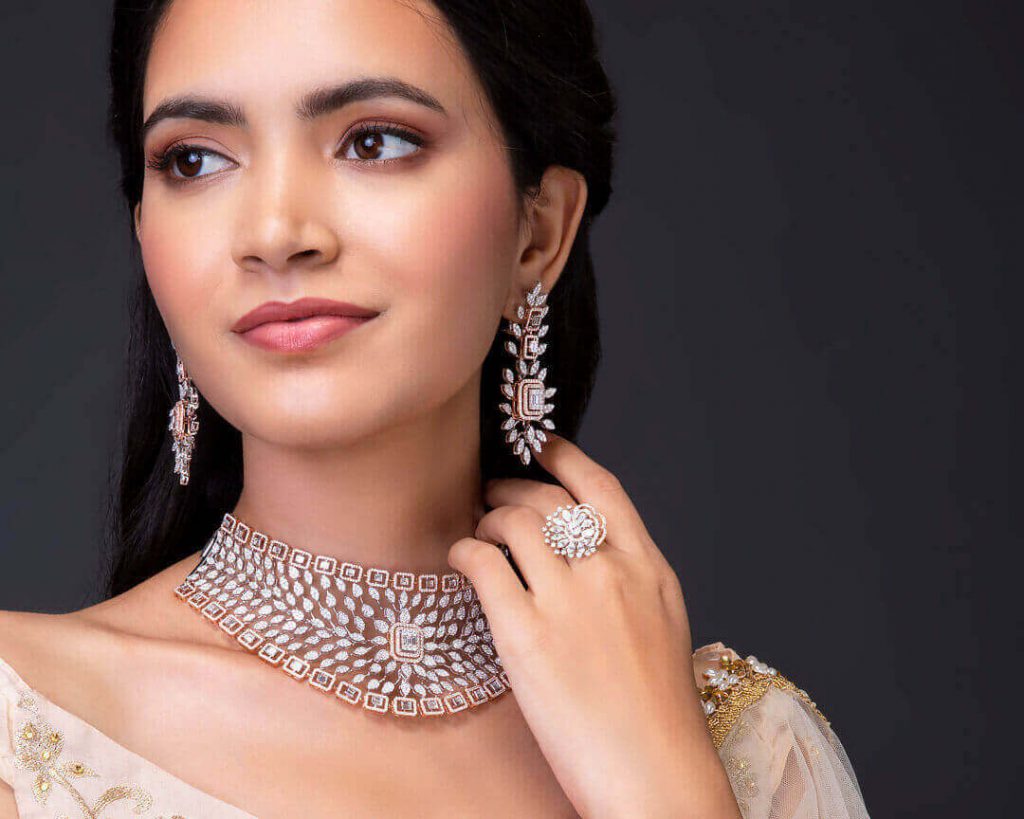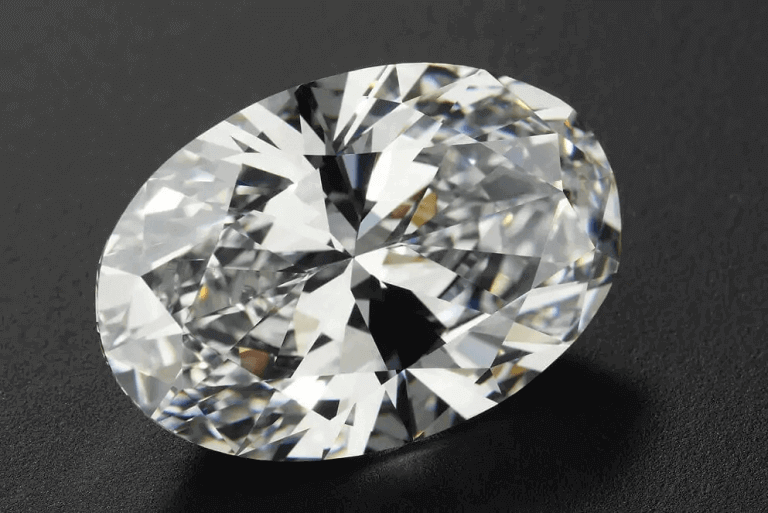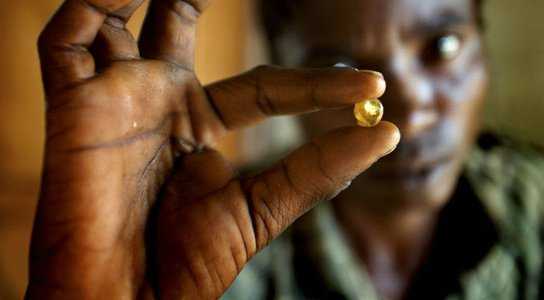
Popular Diamond cut are expertly shaped by jewellers to disperse light effectively, giving the stone its vivacious beauty. A diamond comes in a wide range of shapes, sizes, and cuts to match your choice. Each shape of the diamond has unique characteristics. Some diamond shapes are dazzling and modern, while some are vintage designs. At V.Jayantilal & Co., we have a diverse collection of diamond shapes and ensure that the diamond we craft is unique!
If you want to learn more about diamond shapes, this article is perfect for you.
Looking for a classic diamond shape suitable for every occasion? The round diamond shape is the best choice! Round diamond shapes are one of the most well-liked diamond shapes of all.
Almost 75% of engagement rings are round brilliant cut diamond because of the brilliance of 58 facets that reflect light to create sparkle. Its timeless design and ultimate shine make this cut diamond shape more appealing. V.Jayantilal, a top diamond company, provides high clarity round brilliant cut diamonds in Surat.
When buying a round diamond shape, choose an ideal cut, excellent polish, and symmetry to enhance its brilliance.
If you are looking for a vintage-style ring, buying cushion-cut diamond is a perfect choice! Cushion diamonds are square and rectangular with a beautiful rounded off-cut design that is still wowing brides today.
Always check the depth to be under 70% and the table to be in the same range when purchasing a cushion-shaped diamond. It will help to ensure brilliance and fire throughout the diamond's depth. Cushion-shaped diamonds hide the inclusion very well and exhibit sparkle.
For the one who wants to stand out and love something unique, a pear-shaped diamond is an ideal choice. It is a modified brilliant that combines marquise and oval shapes. It creates an asymmetrical shape with one rounded and one pointed end.
A pear-shaped diamond is also known as a teardrop shape. Pay close attention to the severity of the bow tie when buying the pear-shaped diamond to make sure that it doesn't tarnish the appeal of the diamond. The symmetry grade is also vital when it comes to pear-cut diamonds. Pear-shaped gems have 58 facets. Diamond jewellery made in this shape is trendy due to its distinctive appearance.
Are you looking for a diamond that is suitable for a hustling lifestyle? The radiant diamond shape is a perfect fit. A radiant-shaped diamond is a combination of an emerald and a round brilliant, exhibiting maximum sparkle. Triangular and kite-shaped facets accentuate the charm of a radiant diamond.
The radiant diamond uses the brilliance of a round cut and has a cropped corner and additional facets that give it an emerald-like appearance. The radiant cut is a rectangular-shaped diamond and a cut corner made with 70 facets.
The Asscher shape got its name from the I.J. Asscher diamond company in 1902 in Holland. The Asscher is widely considered similar to an emerald diamond due to its long step-like cut. However, the emerald has a rectangular shape, while the Asscher diamond has a square shape.
The Asscher diamond features long facets, a high crown, and a smaller table, so it shines more brilliantly than emerald-shaped diamonds. It is the popular choice among people who love vintage and antique styles. An Asscher diamond features 58 facets, while a patented royal Asscher diamond has 74 facets.
After the round brilliant, the princess-cut diamond shape is square and the second most popular diamond cut. It is popular due to its brilliance and distinctive cut. Compared to a round diamond shape, the price per carat of this diamond is lower.
It combines round brilliance with a square pointed edge. The colour emitted from the princess-cut diamond is unique. It not only displayed the distinct colour in the centre but also in each of the corners as well.
It had 57 to 76 facets. For maximum sparkle and fire, the arrangement is similar to that of a round diamond stone. Due to their brilliance, they tend to blend well with almost all engagement rings.
If you are looking for a traditional look with a contemporary twist, oval diamond shapes are a great choice! Its elongated shape gives rings an eye-snatching appeal to the finger. As with a pear-shaped diamond, an oval diamond shape also consists of a bow tie. An oval diamond shape consists of 55 facets.
If you are looking for a good piece of diamond without spending a hefty amount, an emerald-shaped diamond is a perfect choice! An emerald-shaped diamond is rectangular and has long, step-like cuts.
Emerald shapes are the ideal choice for the ring, earrings, and pendants! When buying an emerald-shaped diamond, pay extra attention to the clarity of the diamond. An emerald diamond shape is a preferred choice for anyone desiring to buy a large stone with a limited budget.
Undoubtedly, the
is the most beloved shape of all because of its premium cut, shine, and eye-catching appeal. The heart-shaped diamond features a modified version of the brilliant cut.
Heart-shaped diamonds are the ultimate sign of love. When buying a heart-shaped diamond, always opt for a diamond that appears evenly shaped, brilliant, and has a good length-to-width ratio.
If you are looking for a larger stone at the same carat, check out the marquise-shaped diamond! The marquise-shaped diamond got its name from the marquise of the pompadour. It has a long and narrow cut in shape like a football. When buying a marquise-shaped diamond, always pay attention to the symmetry and design of the diamond.
For many, selecting the ideal diamond can be challenging. At V.jayantilal & Co., we strive to offer our clients the highest quality diamonds in Surat. We hope this information was helpful to you with the basic understanding of the diamond shape.
At V.jayantilal, the collection of the diamonds features different diamond shapes, ranging from round to fancy shapes.

The oval diamond shapes was first introduced in ancient Egypt during the New Kingdom period (1550-1069 BC). This shape was often used to represent the sun god Ra, who was associated with light and life. In fact, the word "Ra" means "sun."
The oval diamond shape has been around for centuries, and it's still very popular in modern designs. It's also known as the "diamond cut" because of the way the facets appear when viewed from above.
The oval diamond shape has been used as a symbol of royalty since ancient times. It represents the sun, and thus, the power of the sun. The sun is also associated with the element fire, so the oval diamond shape is often used to represent the fiery nature of the sun.
There are several ways to make an oval diamond shape in jewelry designs. One method involves using two round diamonds set at different angles. Another option is to use a square cut diamond and then add a smaller round diamond to the top of the square. A third option is to use a rectangular-shaped stone and then add a small round diamond to each corner.
The oval diamond shape has been used since ancient times as a symbol of love and beauty. In fact, the shape was often associated with royalty and nobility. Today, the oval diamond shape is still considered a classic and timeless choice for engagement rings. The oval diamond shape can be found in many different styles and designs. From simple round diamonds to fancy marquise cuts, there are endless possibilities when designing an oval diamond ring.
Oval diamonds are among the most popular shapes in jewelry design. They're also among the easiest to create. Here's how to draw an oval diamond shape.
Draw a circle using a pencil. Then use a ruler to make two parallel lines across the top edge of the circle. These will become the sides of the diamond.
Now draw another line at 45 degrees from the first line. This will form the bottom of the diamond.
Next cut along the top edge of the oval. You should now have two triangles.
Now we need to finish off our diamond shape. We will do this by cutting along the bottom edge of the triangle. This will give us another triangle.
Next, we need to cut out the top part of the oval. You can use any type of cutter you would like. I chose my knife because it was easy to control.
The oval diamond shape is an elegant design that has been used for centuries in jewelry. It is also known as the "diamond cut" because it resembles a natural diamond.
This pattern is often seen in nature, such as in flowers, leaves, and even animals. It's also commonly used in architecture, art, and fashion.
The oval diamond shape pattern is one of the most popular patterns in jewelry design. It has been used since ancient times and continues to be used today.
Our Oval Diamond Shape purchasing overview has looked at various characteristics of oval cut diamonds, however, you might say the most important for numerous customers is just how much it sparkles.
Oval cut diamonds of sparkle, yet they lose to the round fantastic when it comes to many sparkles. This is due to the fact that the elements of the round cut are made to take full advantage of fire, radiance and scintillation. Nonetheless, as we have actually already discussed, the still substantial luster as well as a shimmer of the oblong cut ruby, incorporated with the considerably lower price tag, makes the oblong cut an amazing option.

Since time immemorial, Natural Diamonds have been associated with royalty and aristocracy. They are one of the most precious gems held close to their hearts by people worldwide.
But have you ever wondered how humans discover these glamorous pieces of stones?
The easy answer to this question is "mining." Like every other precious element, diamonds too are excavated from the earth's surface employing mining.
However, just like the gems themselves, their mining also has a very interesting history.
Believed to have started somewhere around the 4th century BCE in India. Every continent in the world today is mining diamonds. And each one of them has a uniquely fascinating story of its own.
So without further ado, let’s dive into it.
The word “mining” might sound like a recent phenomenon. Something born from the European Industrial revolution, but that’s not true.
Humans have been mining for extracting precious metals long before the inception of the Industrial revolution. The methods applied at that time, however, were simpler and more manageable. Especially in comparison to the ones used today.
The mining of diamonds in ancient India falls in the simpler category.
Diamond mining in Ancient India
It doesn’t come as a surprise that India was the pioneer in mining Diamonds, considering that the Indus Valley civilization is one of the oldest civilizations on our planet.
Indians have been mining diamonds since the 4th Century BCE.
According to the ancient texts of that time, like Arthashastra by Kautilya, the prestigious stones, were washed ashore by water bodied like rivers and lakes. Later, people recognized these stones as precious diamonds.
The Indians employed the alluvial mining method to excavate the rough diamonds from the mud, stones, and other underwater elements. Royalties later used these diamonds to make jewels.
Such was the proficiency of Indians in mining that they came up with their own system of grading the gems. A Sanskrit scripture named Ratna Parikshan taught the science of testing gemstones.
History credits the Macedonian king Alexander the Great for becoming the first diamond trader.
According to historians, after his defeat at the hands of Porus, Alexander took a hefty amount of Diamond with him in 327 BCE.
However, a proper trade route was not established until the medieval age. This resulted in a tremendous surge in the mining works in India.
Marco Polo has mentioned the drastic effects of demand on supply in his book in 1292. Polo was a famous European traveller, also known for his writings . In one of his works, he has mentioned a diamond mining site in India that employed more than 60,000 people at a time.
Fast-forward to the 17th century, and India had already become the hub for diamond merchants. Britishers introduced more mining projects to meet the demands of the European market.. And the foreigners found a new reserve in South India to fulfill this demand.
The Golconda region became one of the most prominent sites in India. The Kollur mine present in this region produced some of the best diamonds known to men. Yes, you have guessed it right. The Koh-I-Noor also belongs to the Golconda region.
The quality of the diamonds mined from this site was such that the name Golconda Diamond became a benchmark in Europe. It was renowned worldwide as the Diamond capital of that time.
Even today, the word Golconda is present in the English dictionary. The word now means “a source of great wealth.”
Westerners exhausted the Indian mines in the coming time. As a result, they started running out of diamonds to meet the requirement of the Europeans.
That is when Brazil slowly took centre stage as one of the biggest diamond producers.
Brazil had already made a mark on the map of the miners by the end of the 17th century. Its rich deposits of element like gold had already lured several Europeans to establish colonies in this new world.
The Diamonds are said to have been discovered in the early 1700s in the province of Minas Gerias. However, the natives were not really aware of its significance at the start. Instead they used them as dibs for playing cards. It was only after a clerk who had worked at the Golconda mines recognized the priceless gems.
After this discovery, the Portuguese started mining the water body of the Minas region. And discovered a vast deposit of alluvial diamonds.
The first consignment of diamonds was moved out of Brazil to Lisbon in 1728. The exerts there examined and found these diamonds to be of high quality. As a result, more excavation missions were launched in the Minas province. Which resulted in disvovery of more diamonds.
Brazil was the first western country to produce diamonds. It dominated the market for 150 years until the discovery of diamonds in Kimberley, South Africa.
Like Brazil and India, the first diamonds found in South Africa were also alluvial. Kymberlite deposited precious gems on the banks of water bodies.
Deposited on the banks of water bodies after being carried to the surface by Kymberlites.
In fact, the first diamond here was discovered by a 15-year-old boy named Erasmus Jacob. He found it on the south bank of the Orange River.
However, later these diamonds started appearing in places far from water bodies. They were first discovered in yellow soils and later below hard rocks called blue grounds.
This discovery led to the start of the world's first underground mining of diamonds.
In an article, the Mining Council has mentioned has mentioned the history of first diamonds in South Africa. According to that article, the first one of them were found on the Vooruitzich farm in 1871. It belonged to the De Beers brothers. And British government forced them to sell it to a merchant named Alfred Ebden.
Workers dug the first underground mine by bare hands. This site was named "The Big Hole," spreading over a surface area of 273 hectares. It was 463 meters wide and had a depth of 240 meters, making it the biggest diamond mine excavated by hands in the history of humanity.
One other mine operated on the same farmland was named De Beers mine. It later served as an inspiration to the formation of the famous diamond company De Beers.
In the next 15-20 years, around 50 thousand miners worked upon these excavation sites. And curated almost 2,720kg or 13,600,000 carats of diamonds.
This was more than the diamond produced in India over the past 2000 years.
The world of diamond mining has expanded drastically in the last 100 years. All courtesy to the discoveries made in South Africa.
The studies based on the mining done in Africa opened doors for other countries to determine and discover new sites. As a result of which, around 25 countries across the seven continents today are producing diamonds.
The major production however is being controlled by Australia, Botswana, Russia, Congo, and South Africa. These countries are mining in a manageable and sustainable manner to ensure the consistent supply of these marvelous gems worldwide.

